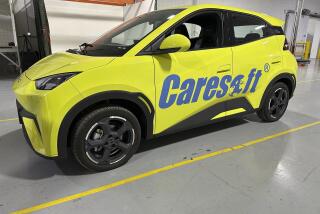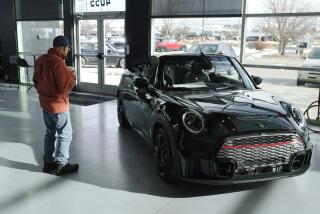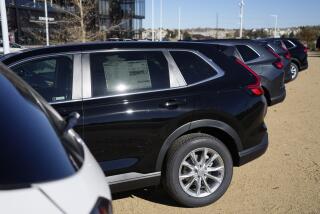Sticker Shock : High New Car Costs Drive Consumers to Buy Used Vehicles
DETROIT — When Cynthia and Brad Burshnell’s long-suffering 1985 Mazda conked out for good last month, they dreamed of a shiny new Honda Accord or Ford Explorer taking its place in their driveway. But after checking out the sticker prices at some local new car dealers, the young Fontana, Calif., couple quickly realized they were looking on the wrong side of the lot.
“I try and keep us on a strict budget, and a good part goes to house payments and feeding the kids,” says Cynthia Burshnell, 27, who helped her husband Brad pick out the used Mitsubishi pickup they eventually bought. “There was just no way we could make the payments on a new car.”
As the average American’s buying power stagnates and car production costs rise, U.S. auto companies are steering away from building the no-frills cars that often were the only new vehicles first-time and lower-income buyers could afford. Instead, car makers increasingly are going upscale, with bigger, more expensive models that offer higher profit margins.
As a result, people like the Burshnells, who have three children and an annual household income of $40,000, are among the growing number of cash-strapped Americans for whom buying a new car has become an unaffordable luxury.
At a time when frugality is trendy and ostentation is out, even people for whom price is not a barrier are considering used cars as an option.
For more than a decade, the cost of new cars has been rising faster than Americans’ paychecks. In 1980, for example, the average family spent about 19 weeks of its total income on a new car. It now takes nearly 26 weeks to pay for the average car.
Auto makers and banks have helped cushion new-car sticker shock by extending the terms of auto loans, from an average of less than four years in 1980 to nearly five years today. Longer loans have helped keep car buyers’ monthly payments relatively low. But with loan maturities stretched about as far as they can go, the auto industry can no longer rely on extended financing to keep cars affordable. And now, the sluggish economy is driving even more customers away from new car lots.
“We’re at a point right now where consumers just can’t take more money out of their household budgets to spend on an automobile,” says Maryann Keller, an auto analyst at Furman Selz in New York. “Unless the industry finds a way to provide more affordable transportation for those families now squeezed out of the market, there will probably be little growth in the 1990s.”
Despite the inherent limitations it puts on growth in the U.S. market, Keller does not expect the industry’s strategy to change. Aging baby boomers account for a large segment of consumers who want to buy the upscale cars the industry is building, and as the economy recovers, auto makers will be able to turn a profit by selling a smaller volume of higher-priced cars.
“The industry is able to rationalize it because it says only 5% to 10% of the customers buy that (low-priced) kind of car,” Keller says. “Well, that’s a considerable number of people in a 10-million car industry . . . It used to be you could get out of college, get a job and buy a (new) car. That’s not possible anymore. We have permanently altered the composition of who can buy what.”
Rising new car prices are reshaping the way Americans think about their primary form of transportation. While the concept of a car as a reflection of character is deeply ingrained in the American psyche, the belief that newer is better has begun to lose its currency.
Wendy Hargis, for example, wanted to replace the brown Ford Escort that she says “wasn’t doing much for my image” with a new electric red Thunderbird. But while she was disappointed to find she couldn’t afford even the base model at $16,300, she says the used one she ended up buying is even better.
“It’s the exact same color and it’s totally loaded,” says Hargis, 26, who works as a legal secretary in Santa Rosa, Calif.
Affordability wasn’t an issue for Richard Nemitz, a Long Beach man who earns upward of $50,000 at his engineer’s job. He says he could have easily afforded the $15,000 for a 1992 Toyota Camry, but bought a used 1991 model on principle instead.
“I looked at everything from Mercedes Benz down to Hyundais, and I liked the Camry the best,” Nemitz said. “But they were just outrageously priced. A car gets you from point A to point B, there’s no point pouring money into a new one.”
Industry observers say more families are likely to follow the lead of Nemitz, Hargis and the Burshnells by opting for a used vehicle. And many already have. Each year since 1989, franchised car dealers have sold more used cars and trucks than new vehicles. As this trend continues, dealers are scrambling to expand that part of their business.
Nickolas Shamas, who owns seven franchises in downtown Los Angeles, said demand for used cars has nearly doubled over the last year, as price-conscious consumers increasingly shunned new models. At the same time, decent used cars have become a scarce commodity.
“We’re telling our buyers to buy as much as they can, and we’re allowing a lot more on trade-ins too,” Shamas said. “This is a town, after all, that you have to have a car in, so people that can’t buy new buy used.”
The used car shortage is due in part to the sharp cut in the number of cars the Big Three U.S. auto makers sell to rental companies. When consumer demand dropped during the recession, the domestic auto makers kept factories running by selling fleets of cars to rental companies every four months. The nearly new cars were then repurchased by the manufacturers and sold at auctions to dealers.
But the short-term recession remedy hurt the Big Three more than it helped as new car shoppers opted to pay thousands less for the former rental cars than they would have for the nearly identical new models. Now, the industry has lengthened the cycle of their repurchasing programs to six months in an effort to make the used car market less attractive to prospective consumers.
Well aware of the growing demand for used cars, U.S. and Japanese auto makers last month announced average price hikes on their 1993 models of less than 3%. But analysts say even those modest increases may further delay the industry’s recovery.
And some contend that unless car and truck prices are scaled down to match American consumers’ ability to pay for them, new car sales will remain considerably below the levels of the mid-1980s.
Americans paid an average of $17,625 for a new car in the first six months of 1992, $10,051 more than they did in 1980. To be sure, car buyers are getting more for their money. Part of the reason for the dramatic increase is that today’s average car is bigger, safer and has more gadgets than a decade ago.
The lowest-priced model of the Toyota Corolla--once the quintessential economy car--now costs $11,198, up 74% since 1983. But the 1993 version of the sedan is longer, wider and has more features than its predecessor. It comes with a driver-side air bag, side-door impact beams and adjustable seat belts. It sports color-keyed bumpers, an electronic speedometer, breakaway outside mirrors, a dual cup holder, a passenger vanity mirror and fabric seats.
It has, in other words, strayed rather far afield from its economy car roots.
The Corolla’s move upscale follows a well-worn evolutionary path that extends throughout the industry, forged in part by shifting consumer tastes and increased government regulation. As gasoline prices remained low, baby boomers with growing families opted for minivans and larger family sedans with more high-tech options.
Auto makers responded by adding more options to their base models, driving up the average cost of new cars. (Industry executives like to point out that the price of similarly equipped cars rose slightly less than the rate of inflation during the last decade.)
“People switched from hamburger to steak,” says Joel Pitcoff, research director at Ford Motor Co. “That doesn’t mean the price of meat went up.”
But those who can’t afford steak say it’s hard to find the car market’s version of a hamburger these days.
Kim Sherman, 25, wants to replace the bare-bones 1986 Hyundai she bought used a few years ago, but the only new car she can afford is the $7,000 Geo Metro. Instead, the Glendale resident says she’s looking for an old Volkswagen Beetle convertible, which, she says, “would at least have some character.”
In the early 1980s, someone like Sherman would have had more new car options to choose from. But auto makers have gradually eliminated what used to be the “base” version of most models, preferring to focus on building more expensive models with higher profit margins.
The results of that shift is reflected in the growing income gap between new car buyers and the average American family.
The median household income of new car buyers in 1986 was $35,600, 26% above that of an average U.S. household, according to figures supplied by the Motor Vehicle Manufacturers Assn. By 1990, the gap had grown to 42%.
Ford’s Pitcoff notes that median family income statistics include people who are retired, unemployed and below the poverty line.
“I don’t remember seeing anything in the Bill of Rights that says everybody should be able to afford a car,” Pitcoff says. “I think it’s remarkable that (the income statistics) are as close as they are.”
Despite improved manufacturing techniques, auto makers say it is hard to build a profitable entry-level car today, especially in the competitive U.S. market.
Three of the eight car models selling for less than $7,000 in the United States--the Subaru Justy, the Yugo and the Daihatsu Charade--are being withdrawn from the U.S. market. Despite strong sales of its entry-level Saturn, which costs $9,195, GM is years away from turning a profit because of the huge initial investment required to start up Saturn production.
And while Chrysler Corp. claims to be developing the first profitable small car built by a U.S. auto maker, David Bostwick, director of marketing and business research, says the company’s entire product line is aimed at “more higher-income, younger people than ever before.”
Thomas Elliott, executive vice president of American Honda Motor Co., says his dealers are clamoring for a less-expensive car than the $11,000 Civic sedan.
“We’d like to have a cheaper car, but it’s not in the immediate picture right now,” Elliott said recently. “The question is, ‘Can you build it and sell it cheaper than the Civic?’, and that’s a pretty tough problem.”
A Bigger Bite Buying a new car is taking a bigger chunk of family incomes. The following shows how many weekly paychecks it takes to buy a car for an American household making the median income. In 1992, that’s just over 25 weeks, making $687 a week, to afford the average new car, priced at $17,628. Source: Commerce Department
But It’s Only a Car. . . In 1967, the average new car cost 40% of the annual income of the median American family. This year, it’s nearly 50%. That’s because the price of an average new car has soared from $3,212 to $17,628 in the past 35 years.
Raising the Price of a Corolla Here’s a list of equipment changes in the Toyota Corolla between 1983, when the lowest priced model cost $6,438, and 1993, with the model now selling for $11,198.
Various engine improvements and changes. Single overhead cam engine replaced by dual overhead cam, multi-valve engine. Increases in horsepower (from 70 HP to 105 HP) and torque (85 lb ft to 100 lb ft). Also, new 1.8L multi-valve engine introduced in 1993, which is standard on deluxe models.
Electronic fuel injection
Front wheel drive
Major NVH improvements: fluid filled engine mounts; sandwich panels; asphalt sheeting
Vented front disc brakes
Anti-lock brakes optional on all models
Auto-off headlamps
Gold-plated wire harness connector terminals for increased reliability for important circuits
Use of anti-rust steel sheets increased to 87% body weight, from 63%.
Color-keyed bumpers
Electronic speedometer
Improved tires
Front and rear stabilizer bars
Longer wheelbase, length, width & height (more interior room)
Power steering (deluxe level)
Halogen headlamps
Side door impact beams
Driver side air bag
Breakaway outside mirrors
Remote outer mirrors (deluxe level)
Fabric seats and trim
Intermittent wipers
Dual cupholder
Remote trunk and fuel door releases
Digital clock (deluxe level)
Rear folding seats with security locks (deluxe level)
Center console box/door map pockets
Fabric headliner/passenger vanity mirror
Fully lined trunk with lamp
Full wheel covers
3-point rear safety belts
Fuel level warning lights
Assist grips






